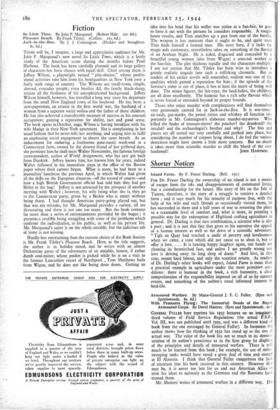Armoured Warfare. By Major-General J. F. C. Fuller. (Eyre and
Spottiswoode. 8s. 6d.) With Pennants Flying : The Immortal Deeds of the Royal Armoured Corps. By David Masters. (Eyre and Spottiswoode. 9s.) GENERAL FULLER here reprints his 1932 lectures on an imaginary third volume of Field Service Regulations (the actual F.S.R.. Vol. III, was not published until 1935, and was a different kind of book from the one envisaged by General Fuller). In footnotes the author shows how the thinking of 1932 has stood up to the test of actual war. The value of the book lies not so much in its demon- stration of its author's prescience as in the firm grasp he display of the principles and details of armoured warfare. There is stil much to be learned from this book ; for example, the use of mine- sweeping tanks would have saved a great deal of time and energy at El Alamein. I think that General Fuller exaggerates the lack of attention that his book received in this. country. However that may be, it is never too late for us and our American Allies t3 treat his ideas as seriously as the Germans and the Russians have treated them.
Mr. Masters. writes of armoured warfare in a different way. Hi concern is not with strategy and tactics, but with the heroic exploits of the men who man the tanks. Within its limitations, his book is a good one. He may not often help us to appreciate the battles in which tanks have been used, but he does something at least as important, he helps us to understand the morale of the men of the Royal Armoured Corps, and he gives us a just and healthy pride in their heroic exploits. A race which can not only produce thinkers like General Fuller but men like the scores of all ranks who appear in Mr. Masters's book is very far from decadent.



























 Previous page
Previous page